 The return capsule of the Shenzhou XV manned spaceship, carrying astronauts Fei Junlong, Deng Qingming and Zhang Lu, touched down at the Dongfeng landing site in North China's Inner Mongolia autonomous region safely on Sunday. (GU JIANWEN / CHINA DAILY)
The return capsule of the Shenzhou XV manned spaceship, carrying astronauts Fei Junlong, Deng Qingming and Zhang Lu, touched down at the Dongfeng landing site in North China's Inner Mongolia autonomous region safely on Sunday. (GU JIANWEN / CHINA DAILY)
The Shenzhou XV mission crew returned to Earth on Sunday morning after a six-month mission that witnessed the completion of the Tiangong space station.
A reentry capsule carrying the crew members — mission commander Major General Fei Junlong, Senior Colonel Deng Qingming and Senior Colonel Zhang Lu — touched down on Earth at the Dongfeng Landing Site in northwestern China's Gobi Desert at 6:33 am after flying for nine hours in a reentry trajectory.
Ground recovery personnel soon opened the hatch of the capsule and conducted a preliminary examination of the astronauts' condition
Ground recovery personnel soon opened the hatch of the capsule and conducted a preliminary examination of the astronauts' condition.
The crew members told ground controllers in Beijing via radio that they had safely landed and were "feeling pretty good".
After preparatory work, ground personnel carried the astronauts out of the capsule one by one to place them on chairs in front of the capsule.
ALSO READ: Shenzhou XV taikonauts complete 4th spacewalk, setting record
While seated, the astronauts shared their feelings and thoughts with a reporter from China Central Television in a live program.
Fei, who was on his second spaceflight, said his crew has completed all of their tasks before returning safely to the motherland and all of them "are in good condition".
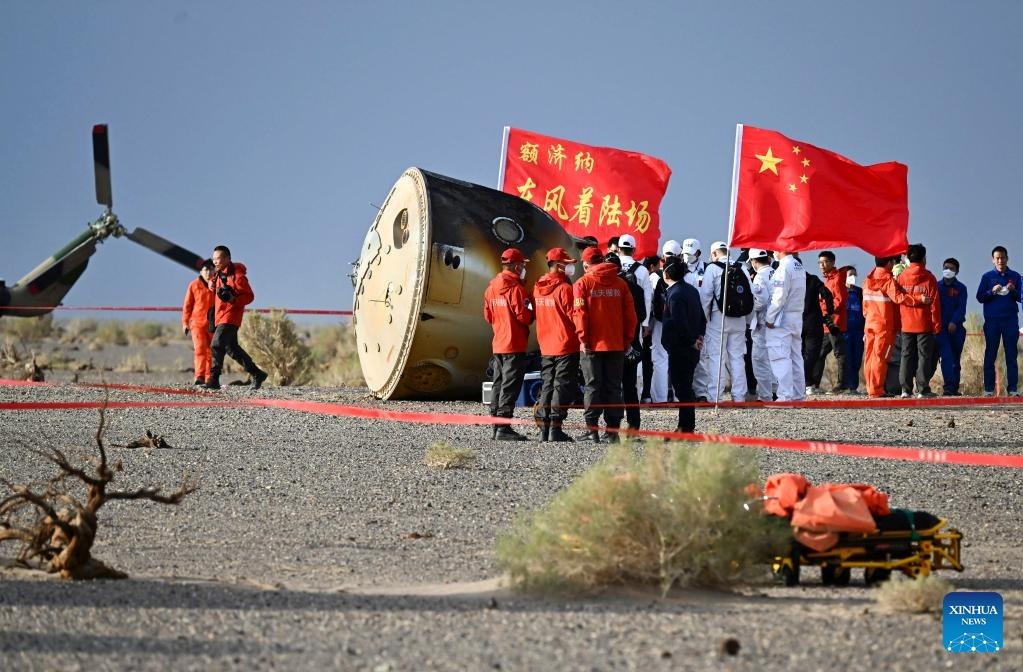 The return capsule of the Shenzhou XV manned spaceship touches down safely at the Dongfeng landing site in north China's Inner Mongolia autonomous region June 4, 2023. (PHOTO / XINHUA)
The return capsule of the Shenzhou XV manned spaceship touches down safely at the Dongfeng landing site in north China's Inner Mongolia autonomous region June 4, 2023. (PHOTO / XINHUA)
Deng, the last in the first generation of Chinese astronauts to go to space, told the State broadcaster that he was very happy to return to "the embrace of Earth and my motherland" and see so many friends.
"At this moment, I wish to thank all Chinese people for their attention, support and encouragement. I also want to thank all space industry workers involved in this mission for their company over the past over 180 days," he said.
Deng trained 25 years only to wait for an opportunity to fly into space, becoming an icon of Chinese astronauts' perseverance and devotion
Deng trained 25 years only to wait for an opportunity to fly into space, becoming an icon of Chinese astronauts' perseverance and devotion.
Sitting in front of the landing capsule, Deng said his experiences over the past 25 years had reinforced his belief in the power of dream and persistence.
"No matter how old I am, knowing that I could be summoned to serve the motherland is always the happiest thing to me," he said.
Zhang recalled that he often tried to spot China, his hometown in Hunan province as well as the Dongting Lake when the Tiangong space station flew over the country.
"Though these places were often hidden by thick clouds, they were always in my heart and mind. We will go back to training as soon as our body condition permits. We will always be ready to return to space to contribute to this great 'New Era' and fulfill the duties given by the Party and the people," he said.
After the interview, the astronauts were moved into special vehicles for health checks.
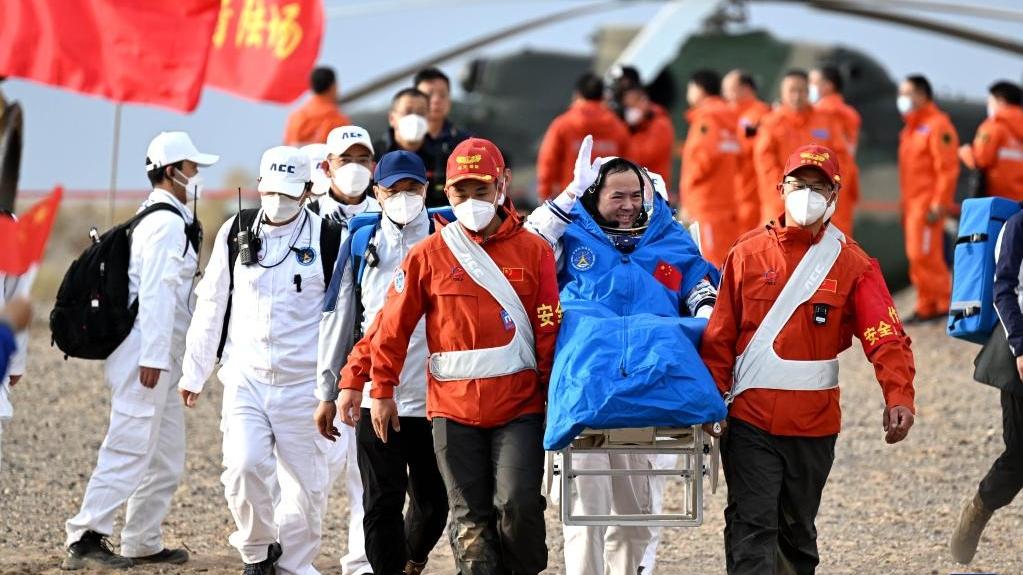 Astronaut Zhang Lu is out of the return capsule of the Shenzhou XV manned spaceship at the Dongfeng landing site in north China's Inner Mongolia autonomous region, June 4, 2023. (PHOTO / XINHUA)
Astronaut Zhang Lu is out of the return capsule of the Shenzhou XV manned spaceship at the Dongfeng landing site in north China's Inner Mongolia autonomous region, June 4, 2023. (PHOTO / XINHUA)
Over the next couple of hours, they were to be transferred to a nearby airport, where they would board a jet to fly back to Beijing.
As the fourth group to go to the Chinese station, Fei and his teammates were launched from the Jiuquan Satellite Launch Center in northwestern China on Nov 29 and entered the space station the next day to meet their Shenzhou XIV peers. The two crews' meeting marked the first time six Chinese people were traveling in outer space at the same time and also the first in-orbit handover between two Chinese crews.
By Saturday night, they had stayed in orbit for 186 days.
During their stay, the Tiangong was announced to be completed at the end of 2022.
The crew successfully obtained three-dimensional structural images of their skin cells with the country's self-developed two-photon microscope
The Shenzhou XV team carried out four spacewalks and installed a host of equipment outside the Tiangong, becoming the most experienced Chinese crew in terms of extravehicular activity. They also conducted dozens of science experiments and technology tests and obtained a great deal of data.
Before setting out on their return trip, Fei's team configured the Tiangong, transmitted science data back to Earth and sorted and transferred materials between the station and their spaceship.
The crew successfully obtained three-dimensional structural images of their skin cells with the country's self-developed two-photon microscope.
This achievement, the first of its kind worldwide, marked the success of the in-orbit verification experiments of the two-photon microscope, providing a promising tool for future health monitoring of astronauts in orbit.
 Astronaut Deng Qingming is out of the return capsule of the Shenzhou XV manned spaceship at the Dongfeng landing site in north China's Inner Mongolia autonomous region June 4, 2023. (PHOTO / XINHUA)
Astronaut Deng Qingming is out of the return capsule of the Shenzhou XV manned spaceship at the Dongfeng landing site in north China's Inner Mongolia autonomous region June 4, 2023. (PHOTO / XINHUA)
China also successfully performed the first in-orbit ignition test in the Mengtian space lab module's combustion cabinet during the Shenzhou XV mission.
The test verified the functions of the combustion science experimental system of the space station and the accuracy and scientificity of the overall experimental process.
China also completed in-orbit experiments on liquid metal thermal management on its space station for the first time ever during the Shenzhou XV mission
In addition, it is worth mentioning that the operation of the country's Stirling thermoelectric convertor realized its in-orbit verification. The heat-to-electricity convertor showed an internationally advanced conversion efficiency during its smooth operation, according to the CMSA.
China also completed in-orbit experiments on liquid metal thermal management on its space station for the first time ever during the Shenzhou XV mission.
These experiments verified a series of key technologies concerning bismuth-based metal in microgravity, such as controlled melting, expansion and convection heat transfer.
As of May 29, they had conducted eight human factors engineering research activities, 28 space medical experiments and 38 space science experiments covering life ecology, material science and fluid mechanics, and obtained valuable experimental data.
The crew also moved cargo outboard several times and installed several items of equipment, including extravehicular extended pump sets, cross-module cables, and supporting devices for the extravehicular payload platform, laying a foundation for carrying out subsequent large-scale science and technology experiments outside the space station, according to the CMSA.
The crew witnessed the completion of the country's space station construction.
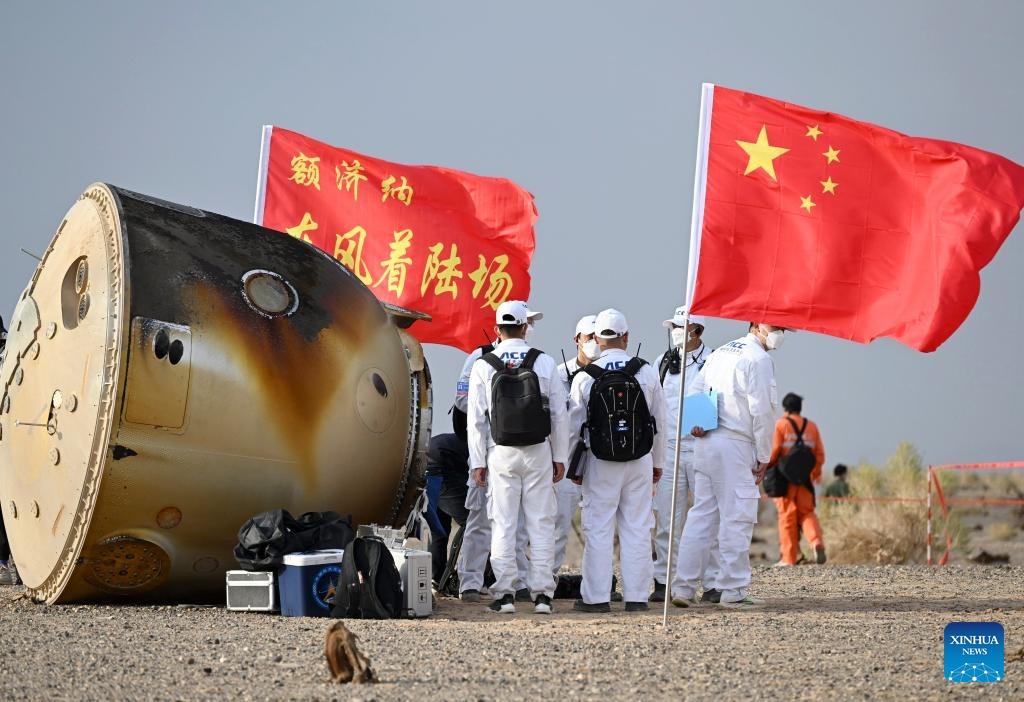 The return capsule of the Shenzhou XV manned spaceship touches down safely at the Dongfeng landing site in north China's Inner Mongolia autonomous region June 4, 2023. (PHOTO / XINHUA)
The return capsule of the Shenzhou XV manned spaceship touches down safely at the Dongfeng landing site in north China's Inner Mongolia autonomous region June 4, 2023. (PHOTO / XINHUA)
On Friday afternoon, a brief handover ceremony took place inside Tiangong, with Fei and his crew members formally giving control of the massive station to the Shenzhou XVI flight team that arrived on Tuesday.
On Saturday night, the Shenzhou XV astronauts moved into their spacecraft and left the Tiangong space station at 9:29 pm.
Their successors, the Shenzhou XVI crew — mission commander Major General Jing Haipeng, Colonel Zhu Yangzhu and Professor Gui Haichao, who is the first Chinese civilian in space — will run the Tiangong, one of the largest pieces of infrastructure ever deployed in Earth's orbit, for five months and are scheduled to return in November.
 Astronaut Zhang Lu is out of the return capsule of the Shenzhou XV manned spaceship at the Dongfeng landing site in north China's Inner Mongolia autonomous region June 4, 2023. (PHOTO / XINHUA)
Astronaut Zhang Lu is out of the return capsule of the Shenzhou XV manned spaceship at the Dongfeng landing site in north China's Inner Mongolia autonomous region June 4, 2023. (PHOTO / XINHUA)
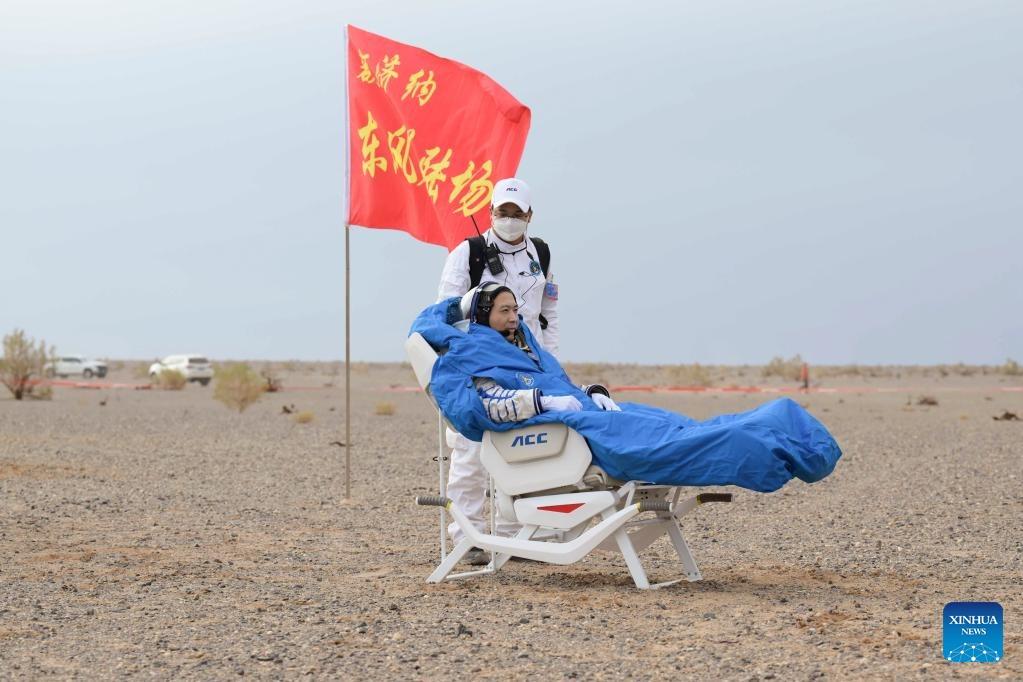 Astronaut Fei Junlong is out of the return capsule of the Shenzhou XV manned spaceship at the Dongfeng landing site in north China's Inner Mongolia autonomous region June 4, 2023. (PHOTO / XINHUA)
Astronaut Fei Junlong is out of the return capsule of the Shenzhou XV manned spaceship at the Dongfeng landing site in north China's Inner Mongolia autonomous region June 4, 2023. (PHOTO / XINHUA)
 The return capsule of the Shenzhou XV manned spaceship touches down safely at the Dongfeng landing site in north China's Inner Mongolia autonomous region June 4, 2023. (PHOTO / XINHUA)
The return capsule of the Shenzhou XV manned spaceship touches down safely at the Dongfeng landing site in north China's Inner Mongolia autonomous region June 4, 2023. (PHOTO / XINHUA)
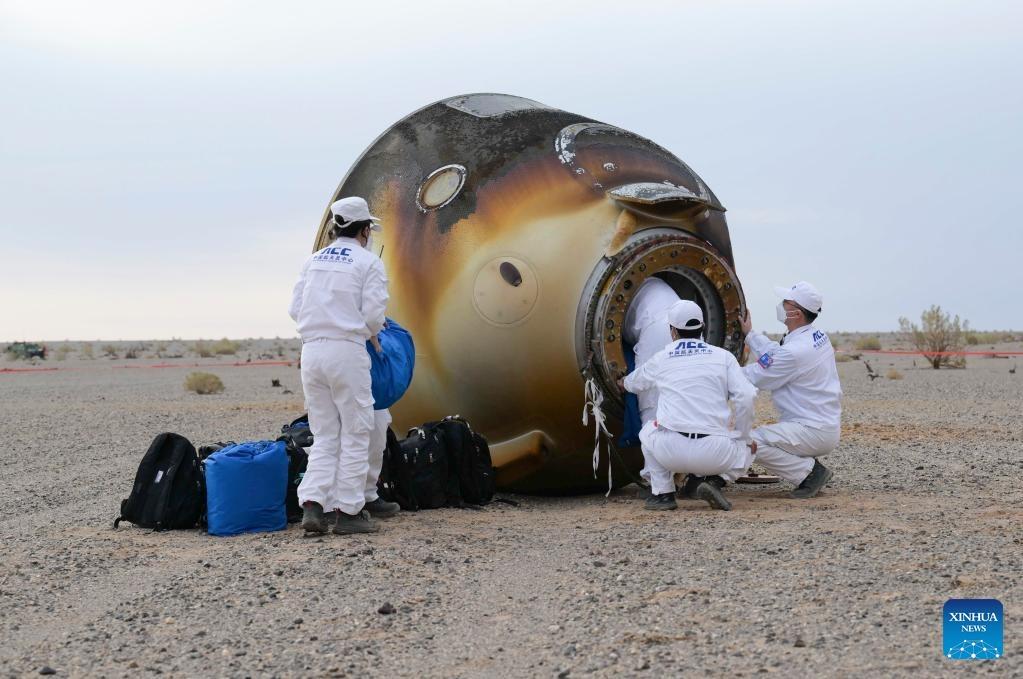 The return capsule of the Shenzhou XV manned spaceship touches down safely at the Dongfeng landing site in north China's Inner Mongolia autonomous region June 4, 2023. (PHOTO / XINHUA)
The return capsule of the Shenzhou XV manned spaceship touches down safely at the Dongfeng landing site in north China's Inner Mongolia autonomous region June 4, 2023. (PHOTO / XINHUA)
With Xinhua inputs


